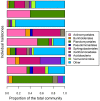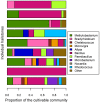Hailstones: a window into the microbial and chemical inventory of a storm cloud
- PMID: 23372660
- PMCID: PMC3553149
- DOI: 10.1371/journal.pone.0053550
Hailstones: a window into the microbial and chemical inventory of a storm cloud
Abstract
Storm clouds frequently form in the summer period in temperate climate zones. Studies on these inaccessible and short-lived atmospheric habitats have been scarce. We report here on the first comprehensive biogeochemical investigation of a storm cloud using hailstones as a natural stochastic sampling tool. A detailed molecular analysis of the dissolved organic matter in individual hailstones via ultra-high resolution mass spectrometry revealed the molecular formulae of almost 3000 different compounds. Only a small fraction of these compounds were rapidly biodegradable carbohydrates and lipids, suitable for microbial consumption during the lifetime of cloud droplets. However, as the cloud environment was characterized by a low bacterial density (Me = 1973 cells/ml) as well as high concentrations of both dissolved organic carbon (Me = 179 µM) and total dissolved nitrogen (Me = 30 µM), already trace amounts of easily degradable organic compounds suffice to support bacterial growth. The molecular fingerprints revealed a mainly soil origin of dissolved organic matter and a minor contribution of plant-surface compounds. In contrast, both the total and the cultivable bacterial community were skewed by bacterial groups (γ-Proteobacteria, Sphingobacteriales and Methylobacterium) that indicated the dominance of plant-surface bacteria. The enrichment of plant-associated bacterial groups points at a selection process of microbial genera in the course of cloud formation, which could affect the long-distance transport and spatial distribution of bacteria on Earth. Based on our results we hypothesize that plant-associated bacteria were more likely than soil bacteria (i) to survive the airborne state due to adaptations to life in the phyllosphere, which in many respects matches the demands encountered in the atmosphere and (ii) to grow on the suitable fraction of dissolved organic matter in clouds due to their ecological strategy. We conclude that storm clouds are among the most extreme habitats on Earth, where microbial life exists.
Conflict of interest statement
Figures





Comment in
-
Environmental microbiology: plant bacteria thrive in storm clouds.Nat Rev Microbiol. 2013 Mar;11(3):146. doi: 10.1038/nrmicro2978. Nat Rev Microbiol. 2013. PMID: 23411853 No abstract available.
References
-
- Delort AM, Vaïtilingom M, Amato P, Sancelme M, Parazols M, et al. (2010) A short overview of the microbial population in clouds: potential roles in atmospheric chemistry and nucleation processes. Atmos Res 98 2–4: 249–260.
-
- Burrows SM, Elbert W, Lawrence MG, Pöschl U (2009) Bacteria in the global atmosphere – Part 1: Review and synthesis of literature data for different ecosystems. Atmos Chem Phys Discuss 9: 10777–10827.
-
- Kourtev PS, Hill KA, Shepson PB, Konopka A (2011) Atmospheric cloud water contains a diverse bacterial community. Atmos Environ 45: 5399–5405.
Publication types
MeSH terms
Substances
LinkOut - more resources
Full Text Sources
Other Literature Sources

